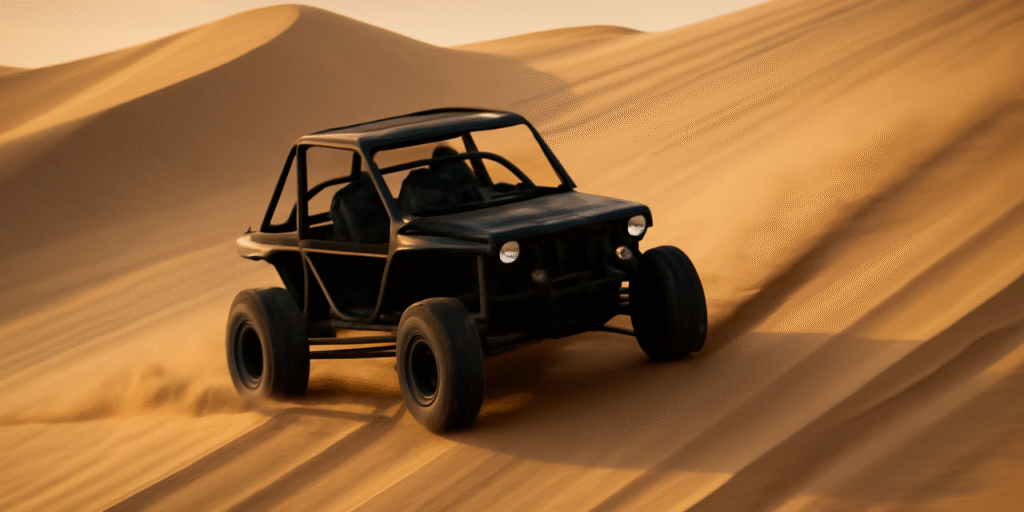Driving on sand is a unique experience that can be both thrilling and challenging, especially compared to driving on the smooth, predictable surface of tarmac. If you’re planning a desert adventure or dune buggy ride, it’s essential to understand the critical differences between these two terrains and how to navigate them. Whether you’re exploring the dunes or driving across a race track, this guide will help you understand the contrast between sand and tarmac driving and offer some expert tips to ensure you have a safe and enjoyable experience.
Key Differences Between Sand and Tarmac Driving
1. Traction:
When driving on tarmac, you benefit from consistent and high levels of grip. The smooth, solid surface ensures your tires maintain firm contact with the ground, allowing for better control and precision. However, when you shift to sand, the situation changes drastically. The loose, uneven nature of sand creates a much lower and inconsistent traction level. Your tires will struggle to grip, often leading to wheel spin or getting stuck. Traction varies across the sand dunes, depending on the compaction level and consistency, and can change within moments.
2. Vehicle Response:
On tarmac, the vehicle’s responses to your actions are immediate and predictable. Steering, acceleration, and braking are direct and accurate, making driving on roads feel controlled and precise. On sand, however, the responses are slower, softer, and less predictable. Steering becomes vague, and braking distances are significantly longer. Smooth and controlled throttle inputs are necessary to prevent the tires from digging into the sand, especially when navigating through loose dunes.
3. Tyre Interaction:
Tarmac tires are designed to reduce rolling resistance, allowing for smooth and efficient movement on solid surfaces. Sand tires, on the other hand, are built differently to handle the unique conditions of loose, granular terrain. They have deep grooves and wide treads to help them “float” on the surface rather than sink. Driving on sand requires more power and energy to move forward as the tires push through the loose surface, creating more drag. This makes vehicle performance more dependent on tire choice and inflation.
4. Weight Distribution and Power Delivery:
On tarmac, a vehicle’s weight distribution is generally balanced, and the engine’s power is consistently delivered to maintain speed and control. However, sand driving requires a more delicate balance. The vehicle’s momentum can be easily lost due to the lower traction, and sudden changes in weight, such as sharp turns or hard braking, can cause the vehicle to lose control. Maintaining a steady pace and smooth handling is essential to keep your vehicle from getting bogged down.

How to Drive on Sand: Pro Tips for Adventurers
1. Reduce Tire Pressure:
One of the most crucial tips for driving on sand is lowering your tire pressure. By reducing the pressure, you increase the surface area in contact with the sand, which improves traction and helps prevent your vehicle from sinking. A common starting point for tire pressure on sand is around 16-20 PSI, but make sure to adjust based on your vehicle and the specific conditions you’re facing.
2. Maintain Steady Momentum:
Momentum is key when navigating through sand. It’s essential to keep your speed consistent, as sudden accelerations or braking can cause your tires to dig into the sand, leading to a stuck vehicle. If you feel the wheels spinning, ease off the throttle to avoid making the situation worse.
3. Smooth Steering and Braking:
On sand, quick or harsh inputs can lead to a loss of control. Steer and brake gently, and avoid sharp turns. Keep your movements smooth to maintain stability, and always plan your route well in advance to avoid sudden adjustments that could send you off course or cause you to get stuck.
4. Use Momentum, Not Power:
When approaching dunes or steep sand hills, it’s important to use your vehicle’s momentum rather than gunning the engine. Build up speed gradually as you approach the dune, and as you crest the hill, ease off the throttle to prevent losing control on the descent.

Driving on Sand Dunes: Expert Tips for a Smooth Ride
1. Survey the Dune First:
Before you tackle a dune, it’s important to assess it from a safe distance. The shape of a dune can deceive, and it may have sharp drop-offs (slip faces) that can be hazardous at high speeds. Always ensure the slope you’re about to climb is manageable and safe.
2. Approach Dunes Head-On:
When climbing a sand dune, always approach it directly (head-on) rather than at an angle. Approaching at an angle increases the risk of your vehicle tipping over or sliding sideways as you reach the crest.
3. Never Stop on a Dune:
Stopping on a sand dune can quickly lead to being stuck. If you lose momentum before reaching the top, reverse down carefully and try again. Avoid attempting to turn around on the dune, as this may cause you to become wedged in the soft sand.
4. Crest Carefully:
As you near the top of a sand dune, ease off the throttle to reduce speed. Jumping over the crest is risky because you can’t see what’s on the other side, and you might land on soft sand, which can lead to losing control. Roll over the top carefully, and only apply power once you have a clear, safe path ahead.
Why Choose Easy Line Tour for Your Sand Adventure?
If you’re looking for an exciting and safe sand driving experience, Easy Line Tour offers the best desert adventures. Whether you’re looking for dune buggy rides or guided desert safaris, our expert drivers and premium vehicles ensure your safety and enjoyment throughout the entire journey.
Experience the thrill of the desert with the guidance of professional instructors who are committed to ensuring you make the most of your sand adventure. With us, you’ll learn how to drive on sand like a pro, all while having a fun and unforgettable time.




